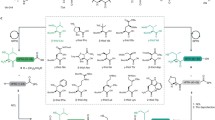Abstract
A series of disulfide bridged peptides were designed as potential inhibitors of protein-protein interactions. Following solid phase synthesis, completely deprotected linear peptides were first oxidized to their disulfide analogs and then transformed into their lanthionine equivalents via a base-assisted reaction in water. Peptides consisting of cystine bridges of length i, i+3, with and without discrimination of the chiral centers, were studied for this transformation. Lanthionine peptides were also obtained directly from the reduced linear peptides under mild alkaline treatment, and the reaction proceeded via disulfide bond formation. The extent of conversion of a disulfide bridge into its lanthionine counterpart varied according to the primary sequence. Product characterization revealed diastereomeric lanthionine formation. The presence of D-amino acids, peptide conformation, and/or position of the cystine bridge are among the factors determining the facility of this reaction. Elimination of the backbone proton beta to the sulfur atom followed by intramolecular thiol Michael addition is the most likely mechanism for this transformation.
Similar content being viewed by others
References
Mulder, G.J., Ann., 28 (1838) 73.
Horn, M.J., Jones, D.B. and Ringel, S.J., J. Biol. Chem., 138 (1941) 141.
Brown, J.B. and du Vigneaud, V.J., Biol. Chem., 140 (1941) 767. b. Brown, J.B. and du Vigneaud, V.J., Biol. Chem., 138 (1941) 151.
Lebl, M. and Hruby, V.J., Tetrahedron Lett., 25 (1984) 2067. b. Nutt, R.F., Veber, D.F. and Saperstein, R., J. Am. Chem. Soc., 102 (1980) 6539. c. Mayer, J.P., Heil, J.R., Zhang, J. and Munson, M.C., Tetrahedron Lett., 36 (1995) 7387.
Fukase, K., Kitazawa, M., Sano, A., Shimbo, K., Fujita, H., Horimito, S., Wakamiya, T. and Shiba, T., Tetrahedron Lett., 29 (1988) 795.
Kelner, R., Jung, G., Horner, T., Zahner, H., Schnell, N., Entian, K. and Gotz, F., Eur. J. Biochem., 177 (1988) 5359.
Zheng, H., Fink, D., Jiang, X.H., Aebi, S., Law, P., Goodman, M. and Howell, S.B., Clin. Cancer Res., 3 (1997) 1323.
Zervas, L. and Ferderigos, N., Isr. J. Chem., 12 (1974) 139.
Polonsky, A., Cooney, M.G., Toy-Palmer, A., Osapay, G. and Goodman, M., J. Med. Chem. 35 (1992) 4185.
Harpp, D.N. and Gleason, J.G., J. Org. Chem., 35 (1970) 3259. b. Harpp, D.N. and Gleason, J.G., J. Org. Chem., 36 (1971) 73.
Shiba, T., Wakamiya, T., Fukase, K., Sano, A., Shimbo, K. and Ueki, Y., Biopolymers, 25 (1986) S11–S19.
Shao, H., Wang, S., Lee, C., Osapay, G. and Goodman, M., J. Org. Chem., 60 (1995) 2956.
Probert, J.M., Rennex, D. and Bradley, M., Tetrahedron Lett., 37 (1996) 2067. b. Yu, L., Lai, Y.,Wade, J.V. and Coutts, S.M., Tetrahedron Lett., 39 (1998) 6633. c. Li, H., Jiang, X. and Goodman, M., J. Peptide Sci., 7 (2001) 82. d. Mayer, J.P., Zhang, J., Groeger, S., Liu, C. and Jarosinski, M.A., J. Peptide Res., 51 (1998) 432.
Earland, C. and Raven, D.J., Nature, 191 (1961) 384.
Danehy, J.P., In N. Kharasch and C.Y. Meyers (Eds), The Chemistry of Organic Sulfur Compounds, Pergamon Press, New York, 1966, 2, pp. 337–349.
Norris, J.D., Paige, L.A., Cristensen, D.J., Chang-Yi, C., Huacani, M.R., Fan, D., Hamilton, P.T., Fowlkes, D.M. and McDonnell, D.P., Science, 285 (1999) 744. b. Leduc, A., Bramlett, K.S., Burris, T.P. and Spatola, A.F., Peptides: The Wave of the Future - 2nd International Peptide Symposium, San Diego, CA, U.S.A., June 9- 14, 2001.
Leduc, A., Masters dissertation, Department of Chemistry, University of Louisville, Louisville, 2001.
Sakakibara, S. and Shimonishi, Y., Bull. Chem. Soc. Japan, 38 (1965) 1412.
Volkmer-Engert, R., Landgraf, C. and Schneider-Mergener, J., J. Peptide Res., 51 (1998) 365.
Andreu, D. and Nicolas, E., In S.A. Kates and F. Albericio (Eds), Solid-Phase Synthesis: A Practical Guide, Marcel Dekker Inc., New York, 2000, pp. 365–375.
Florence, T.M., Biochem. J., 189 (1980) 520.
Swan, J.M., Nature, 179 (1957) 965.
Jones, A.J., Helmerhorst, E. and Stokes, G.B., Biochem. J., 211 (1983) 499.
Cecil, R. and Macphee, J.R., Adv. Protein Chem., 14 (1959) 255.
Toogood, P.L., Tetrahedron Lett., 34 (1993) 7833.
Author information
Authors and Affiliations
Corresponding author
Rights and permissions
About this article
Cite this article
Galande, A.K., Spatola, A.F. A facile method for the direct synthesis of lanthionine containing cyclic peptides. Letters in Peptide Science 8, 247–251 (2001). https://doi.org/10.1023/A:1016285331403
Issue Date:
DOI: https://doi.org/10.1023/A:1016285331403




